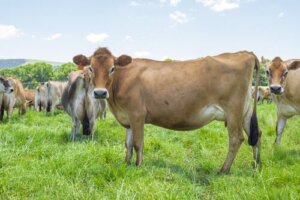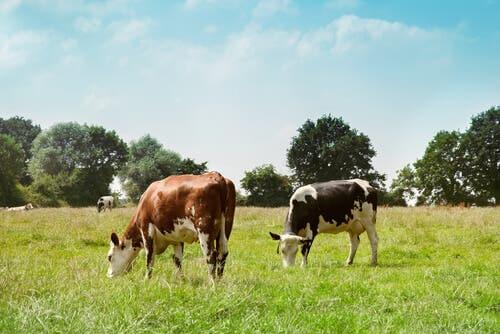The Healthy Breeding of Beef Cattle


Written and verified by the lawyer Francisco María García
Beef is one more the most appreciated and consumed foods in the world. As a result, livestock farming is highly profitable in many countries. The healthy breeding of beef cattle is essential to general business and to maintain high-quality production.
Beef cattle: Biology and behavior
We generally call females of these breeds “cows”. These breeds make up the species of mammals called Bos primigenius or Bos taurus.
Beef cattle stand out for their large, muscular bodies. They have long tails and legs, as well as hooves. Other significant features are their large eyes and thick snouts with large nostrils. Their coats are short and of various different colors. Some breeds also have two hollow horns.
Cattle are intelligent animals with a great capacity to learn. However, they are also strong and resistant. They tend to have a temperate, sociable character when raised in optimal conditions.
Humans have kept cows for many years. In fact, experts suppose that cattle were domesticated for the first time around 8,000 years ago. Currently, the largest producers and exporters of beef are Brazil, Argentina, the United States, and China.

The main breeds of beef cattle
The first step in investing in healthy beef cattle is to choose a breed that’s productive. You’ll also need to consider factors such as available space, weather, altitude, budget, and production expectations.
1. Charolais
This breed originated in France. Specialists consider this breed to produce the best beef. In fact, this is the most demanded breed in all European countries.
2. Simmental
People have bred this Swiss breed of cattle since the Middle Ages. They stand out for their muscular bodies. This breed provides high-quality meat with lots of flavor and very little fat.
These cows are also fast-growing, adaptable, docile, and fertile. This breed also lives a long time. In addition, they offer a win-win situation: they are optimal producers of milk and meat.
3. Aberdeen Angus
This is a medium-sized breed indigenous to Scotland. They are the most popular in the United States, Argentina, and Uruguay. These are highly valued for their fertility, calving ease, and long life expectancy. In addition, the meat is juicy, tasty, and tender.
4. Brahman
This bread was created and developed almost entirely in the United States. They are excellent producers of high-quality meat. In addition, they stand out for their highly-developed young, large size, and fertility.
5. Hereford
Originally from England, this breed won awards for excellence thanks to the quality of its meat. This breed is known for its fertility, long life expectancy, ease of fattening, low-maintenance costs, docility, and adaptability. In addition, they produce high-quality leather.
Healthy breeding of beef cattle: Tips and care
The healthy breeding of beef cattle requires special attention in terms of feeding, reproduction, preventative medicine, and the environment.
Feeding beef cattle
Raising cows for meat requires fast and efficient fattening. However, it’s important to provide quality food to preserve the health of the animal and the quality of the meat.
Many exporting countries use a combined method of fattening animals. The animals spend their first six to nine months grazing freely to prepare their digestive system and strengthen their bodies.

Then, farmers move cattle into pens to accelerate fattening and, therefore, generate higher profits. The animals spend six to eight months ingesting a feed mixture with a high concentration of protein with grains such as corn and soy.
The healthy rearing of beef cattle should focus on the animals’ health as a priority over accelerated fattening. Excess grain and lack of space for grazing often cause serious digestive problems, which can ultimately lead to death.
Natural, extensive grazing in fields with lots of grass is always preferable. When this isn’t possible, you should provide a diet rich in good-quality, natural food. This can help compensate for the lack of grazing.
Hydration
Ruminant mammals need to be hydrated to stay healthy. For example, an adult cow usually drinks 30 liters of water a day. Moreover, high-protein, fattening feed often makes the animal more thirsty.
As a result, it’s important to leave fresh, clean water in a place where the animal can access it throughout the day. Another option is to have an artificial lack (or another water source) in the field. This gives the cattle a place where they can cool off and hydrate.
Preventative medicine
Despite their imposing size, cows can easily become ill from microorganisms present in fields. Therefore, you should consult with a specialized veterinarian to discuss vaccination and deworming.
Supplements, vitamins, and concentrated antibiotics are also often used to strengthen the cows’ immune systems.
Beef is one more the most appreciated and consumed foods in the world. As a result, livestock farming is highly profitable in many countries. The healthy breeding of beef cattle is essential to general business and to maintain high-quality production.
Beef cattle: Biology and behavior
We generally call females of these breeds “cows”. These breeds make up the species of mammals called Bos primigenius or Bos taurus.
Beef cattle stand out for their large, muscular bodies. They have long tails and legs, as well as hooves. Other significant features are their large eyes and thick snouts with large nostrils. Their coats are short and of various different colors. Some breeds also have two hollow horns.
Cattle are intelligent animals with a great capacity to learn. However, they are also strong and resistant. They tend to have a temperate, sociable character when raised in optimal conditions.
Humans have kept cows for many years. In fact, experts suppose that cattle were domesticated for the first time around 8,000 years ago. Currently, the largest producers and exporters of beef are Brazil, Argentina, the United States, and China.

The main breeds of beef cattle
The first step in investing in healthy beef cattle is to choose a breed that’s productive. You’ll also need to consider factors such as available space, weather, altitude, budget, and production expectations.
1. Charolais
This breed originated in France. Specialists consider this breed to produce the best beef. In fact, this is the most demanded breed in all European countries.
2. Simmental
People have bred this Swiss breed of cattle since the Middle Ages. They stand out for their muscular bodies. This breed provides high-quality meat with lots of flavor and very little fat.
These cows are also fast-growing, adaptable, docile, and fertile. This breed also lives a long time. In addition, they offer a win-win situation: they are optimal producers of milk and meat.
3. Aberdeen Angus
This is a medium-sized breed indigenous to Scotland. They are the most popular in the United States, Argentina, and Uruguay. These are highly valued for their fertility, calving ease, and long life expectancy. In addition, the meat is juicy, tasty, and tender.
4. Brahman
This bread was created and developed almost entirely in the United States. They are excellent producers of high-quality meat. In addition, they stand out for their highly-developed young, large size, and fertility.
5. Hereford
Originally from England, this breed won awards for excellence thanks to the quality of its meat. This breed is known for its fertility, long life expectancy, ease of fattening, low-maintenance costs, docility, and adaptability. In addition, they produce high-quality leather.
Healthy breeding of beef cattle: Tips and care
The healthy breeding of beef cattle requires special attention in terms of feeding, reproduction, preventative medicine, and the environment.
Feeding beef cattle
Raising cows for meat requires fast and efficient fattening. However, it’s important to provide quality food to preserve the health of the animal and the quality of the meat.
Many exporting countries use a combined method of fattening animals. The animals spend their first six to nine months grazing freely to prepare their digestive system and strengthen their bodies.

Then, farmers move cattle into pens to accelerate fattening and, therefore, generate higher profits. The animals spend six to eight months ingesting a feed mixture with a high concentration of protein with grains such as corn and soy.
The healthy rearing of beef cattle should focus on the animals’ health as a priority over accelerated fattening. Excess grain and lack of space for grazing often cause serious digestive problems, which can ultimately lead to death.
Natural, extensive grazing in fields with lots of grass is always preferable. When this isn’t possible, you should provide a diet rich in good-quality, natural food. This can help compensate for the lack of grazing.
Hydration
Ruminant mammals need to be hydrated to stay healthy. For example, an adult cow usually drinks 30 liters of water a day. Moreover, high-protein, fattening feed often makes the animal more thirsty.
As a result, it’s important to leave fresh, clean water in a place where the animal can access it throughout the day. Another option is to have an artificial lack (or another water source) in the field. This gives the cattle a place where they can cool off and hydrate.
Preventative medicine
Despite their imposing size, cows can easily become ill from microorganisms present in fields. Therefore, you should consult with a specialized veterinarian to discuss vaccination and deworming.
Supplements, vitamins, and concentrated antibiotics are also often used to strengthen the cows’ immune systems.
This text is provided for informational purposes only and does not replace consultation with a professional. If in doubt, consult your specialist.








